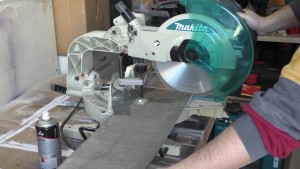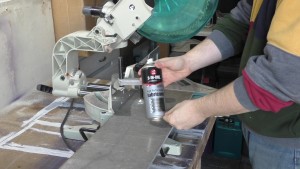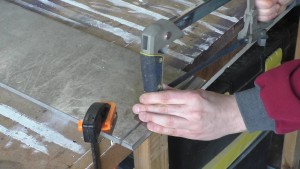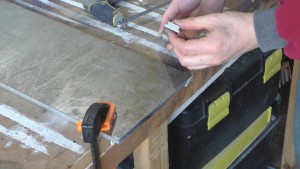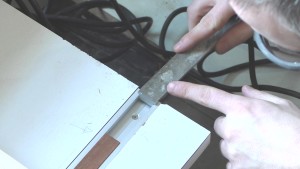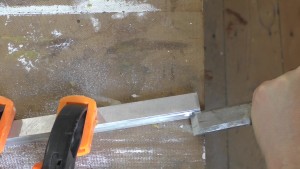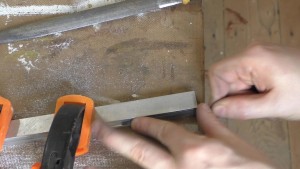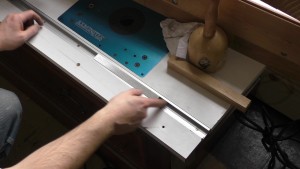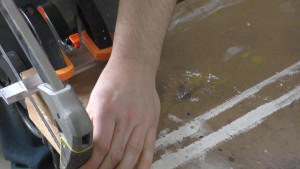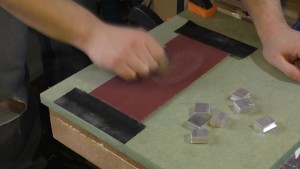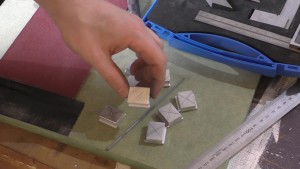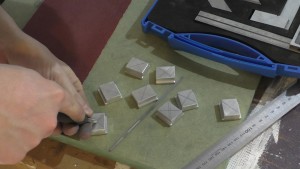I recently installed a t-track into my router wardrobe table and quickly discovered that I didn’t have enough t-nuts to do anything useful. I vaguely remember buying some t-nuts with the track but that was a while ago and time seems to have ensured that all but one has gone missing. What more excuse do I need to try my hand at some metalworking.
Let me start off by saying that I don’t know whether this project should inspire you or act as a warning. Nothing went wrong and the end product is great but it was hard work and it was hard work mainly because I only have woodworking tools. What it does show though is that with a little determination and some lateral thinking woodworkers can do some metalwork, at least with aluminium.
The t-nuts are made from 10mm plate aluminium which a friend very kindly gave me. I loaded it up onto the mitre saw and squared up one edge.
When working any metal lubrication is essential and it is even more important when working with a sticky metal like aluminium. Many people recommend using WD40 on aluminium and I completely agree. For this project though I decided to try an alternative high performance lubricant that includes Teflon.
The results were good but it wasn’t worth the additional cost over plain WD40.
Once the edge has been cleaned up set the depth control on the mitre saw and cut a shoulder along the cleaned up edge to form one side of the T. Move the material across the width of the t-track opening and then cut another shoulder. Finally move the material across again and cut the t-nut blank free.
When you cut the t-nut blank free stop before it actually becomes free. The piece is quite small, it is not secured down to the saw bed and the material you are cutting is sticky this adds up to a real danger the saw blade will pick the piece up and throw it at you.
Clamp the piece to the workbench and using a hacksaw complete the cut to free the t-nut blank from the rest of the stock.
At this point you should have one very long t-nut.
Perform a test fit in the t-track. Check the height of the shoulders and the width of the blank. In my case the width was good but the shoulder height was a little off, they were a bit tall.
When you trench / shoulder cut on the mitre saw the blade won’t cut all the way to the fence. With wood I typically place a block against the fence to bring the piece forward but I didn’t fancy trying that with aluminium so I was left with a couple of uncut areas of shoulder on the blank. I tried cleaning these up with my large blunt file but it was taking forever so I decided to try using a sharp chisel. Surprisingly this worked really well.
Once the bulk was removed with the chisel I went back to files to complete the clean up.
To correct the problem with the shoulder height I could either try to shave some off the top of the shoulder or reduce the thickness of the piece by removing material from the bottom. As I have a belt sander I decided the quickest option would be to reduce the thickness of the piece as a whole. I also cleaned up the top of the blank while I was there.
The belt sander is good for bulk removal of material but for finer work some other method is needed. To do the edges of the t-nut blank I made a simple lapping set up with some 80 grit sand paper. A few strokes are all that is needed. I took the time to break all the edges as well as you don’t want sharp edges catching on the inside of the track.
Sand the piece until the whole blank is a nice easy fit into the t-track. The fact that the whole piece fits into the track is a good indication that the piece and the track are fairly straight.
Divide the blank up into sensible sized lengths. Here I just used the width of my steel ruler (about 25mm) which gave me eight t-nuts and a little bit of scrap.
Use a hacksaw to cut the t-nuts free from the blank.
The hacksaw leaves a burr and very rough edges so go back to the lap and clean up and break the edges. You can try to do this on the belt sander but it’s hard to hold onto the pieces as they are quite small and become hot quickly.
Mark a cross on the top of each t-nut and then centre punch each piece at the intersection of the lines.
Finally drill and thread each part. I’ve threaded M5 as that gave more threads in the t-nut than M6 although I think M6 would probably also work just fine.
Considering how much work this project was I think I’m going to save up for a small milling machine!

